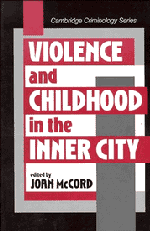Book contents
- Frontmatter
- Contents
- List of Contributors
- Preface
- 1 Violence and the Inner-City Street Code
- 2 The Embeddedness of Child and Adolescent Development
- 3 Placing American Urban Violence in Context
- 4 Neuropsychology, Antisocial Behavior, and Neighborhood Context
- 5 Psychological Mediators of Violence in Urban Youth
- 6 Understanding and Preventing Child Abuse in Urban Settings
- 7 Intervening to Prevent Childhood Aggression in the Inner City
- Name Index
- Subject Index
7 - Intervening to Prevent Childhood Aggression in the Inner City
Published online by Cambridge University Press: 01 June 2011
- Frontmatter
- Contents
- List of Contributors
- Preface
- 1 Violence and the Inner-City Street Code
- 2 The Embeddedness of Child and Adolescent Development
- 3 Placing American Urban Violence in Context
- 4 Neuropsychology, Antisocial Behavior, and Neighborhood Context
- 5 Psychological Mediators of Violence in Urban Youth
- 6 Understanding and Preventing Child Abuse in Urban Settings
- 7 Intervening to Prevent Childhood Aggression in the Inner City
- Name Index
- Subject Index
Summary
“There's been more killing this year than I can ever remember, and I came to Chicago in '51,” he said, He was a 61-year-old grandfather whose young adult son, Andre, had just been beaten to death by five young men, apparently because his son had chided one of them for taunting a young woman in the neighborhood. “We can go to the moon, but we can't do anything about these gangs and drugs and violence. Why? Why?” he asked insistently. “We've got a brain, and it is greater than any machine ever built, but we can't fix this,” he said. “Why? If I could read, I'd read every book in the library until I found an answer.”
(Chicago Tribune, 1992).The weekend of Andre's killing, 28 people were killed in the city of Chicago, most of them young, poor, and from West Side or South Side neighborhoods where killings have become routine and commonplace. These killings rarely make the news, because they are not news but rather everyday events – facts of life in the inner city. They are sometimes motivated by absurd reasons, such as a real or imagined insult. Victims often meet their fate simply by being “in the wrong place at the wrong time,” for instance, by getting caught in crossfire during a clash between rival gangs.
- Type
- Chapter
- Information
- Violence and Childhood in the Inner City , pp. 256 - 312Publisher: Cambridge University PressPrint publication year: 1997
- 9
- Cited by



